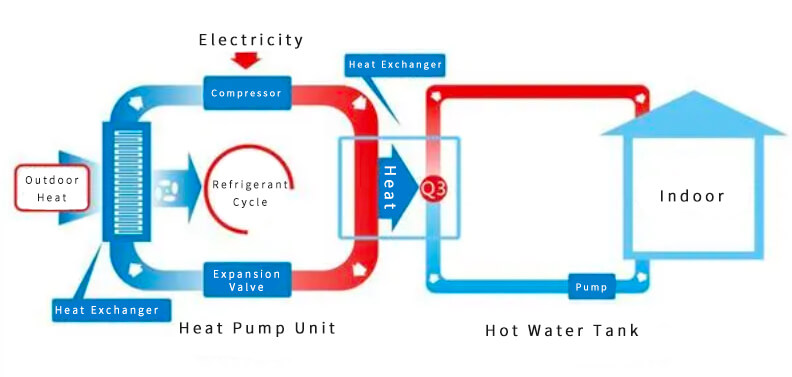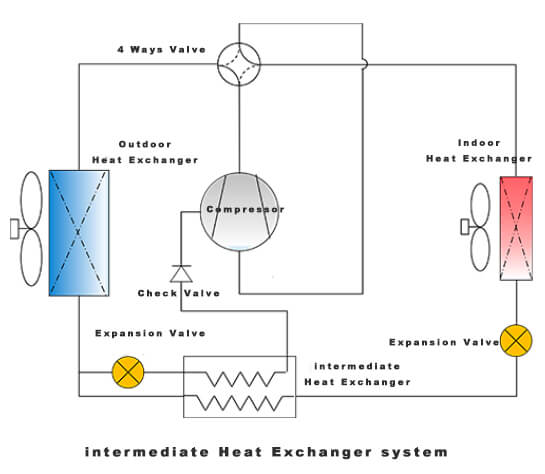Air source heat pumps have gained market traction for their efficiency and environmental benefits. However, performance can significantly vary based on several factors. In colder climates, the efficiency of these pumps decreases, and frost formation during heating can severely impact both efficiency and reliability. To combat these challenges, advancements in technology and design have been made, enhancing the functionality and application of air source heat pumps in various environments.
Advancements in Multistage Compression Technology
Variable frequency compression technology is one of the effective methods to improve the heating capacity of air source heat pumps. In low-temperature conditions, increasing the compressor speed can significantly increase its exhaust volume, thereby improving the heating capacity of the air source heat pump. However, variable frequency technology does not improve system energy efficiency. To simultaneously improve heating capacity and low-temperature energy efficiency, multistage compression technology has been developed.

Depending on the number of compression stages and the cycle structure, multistage compression air source heat pumps can be divided into cascading cycles and dual/multi-stage compression, etc. To improve the heating capacity of single-stage compression systems in low ambient temperatures, refrigerant can be directly injected into the compression chamber during the compression process, known as quasi-two-stage compression. Since quasi-two-stage compression cycles have characteristics of dual-stage compression, this article will include them in the scope of dual-stage compression cycles for discussion.
Cascade Air Source Heat Pumps
Due to the low ambient temperature, the system pressure ratio is high, the compression work is large, and the throttling loss is significant, ultimately leading to low heat pump energy efficiency. To reduce losses and improve efficiency, cascade air source heat pump systems use two vapor compression cycles in series to replace a single cycle, to reduce the compression ratio of the single-stage cycle.
As shown in the figure, the cascade system consists of two independent vapor compression cycles, one is a low-temperature stage cycle, and the other is a high-temperature stage cycle. These two cycles are connected through a common intermediate heat exchanger, which also serves as the condenser for the low-temperature cycle and the evaporator for the high-temperature cycle. In winter, the low-temperature cycle absorbs heat from the ambient air through the evaporator and elevates the heat to a higher temperature to serve as a heat source for the high-temperature cycle; in the high-temperature cycle, the heat is further elevated to the temperature required for indoor heating.

By using a cascade air source heat pump, the cycle’s compression ratio is significantly reduced, reducing overall compression loss and throttling loss, thereby improving the energy efficiency of the air source heat pump. Moreover, depending on different working conditions, the high and low temperature stages of the cascade cycle can use different refrigerants. As the cascade system can be implemented using two simple single-stage systems, it has been used for many years in heating and hot water supply applications. However, the temperature difference in the heat exchange of the intermediate heat exchanger in the cascade cycle inevitably leads to certain efficiency losses; moreover, the cascade cycle requires two compressors and an additional heat exchanger, which makes it more costly compared to single-stage cycles.
Advantages of Dual Stage Compression Air Source Heat Pumps
A dual-stage compression air source heat pump connects two refrigeration cycles together and can be seen as a simplified form of the cascade system. As shown in the figure, based on the different economizers used, dual-stage compression air source heat pumps can be divided into two types: Flash Tank (FT) systems and Intermediate Heat Exchanger (IHX) systems.
For the flash tank system, the liquid refrigerant leaving the indoor condenser is throttled into two phases and then enters the flash tank, where the two-phase refrigerant is separated into saturated vapor and saturated liquid; the saturated vapor refrigerant is mixed with the refrigerant exhaust from the low-pressure stage compressor and then compressed again by the high-pressure stage compressor, the saturated liquid is throttled by the second expansion valve and enters the outdoor evaporator to evaporate into gas and then enter the low-pressure stage compressor, afterwards mixing with the medium pressure gas from the flash tank.

For the intermediate heat exchanger system, the liquid refrigerant from the condenser outlet is directly divided into two paths: main flow and branch flow. The branch flow refrigerant is throttled to intermediate pressure and enters the intermediate heat exchanger, where the low-temperature refrigerant cools the main flow refrigerant to a subcooled state, the branch flow refrigerant absorbs heat and becomes saturated vapor or superheated state and mixes with the exhaust from the low-pressure stage compressor, then enters the high-pressure stage compressor for further compression. The subcooled refrigerant from the main stream outlet of the intermediate heat exchanger is throttled through the evaporator and finally returns to the low-pressure stage compressor, compressed to intermediate pressure, and mixes with the branch flow refrigerant.
Quasi-Dual Stage Compression for Versatility
As shown in the figure, quasi-dual stage compression air source heat pumps (also known as makeup systems) are very similar to dual-stage compression systems. The difference is that in the quasi-dual stage compression, refrigerant from the flash tank or intermediate heat exchanger is injected into the compression chamber of the compressor, instead of between two series compressors.
Therefore, quasi-dual stage heat pumps can be considered a simplified form of dual-stage heat pumps, using specially designed makeup compressors to replace two compressors, thereby avoiding the oil equalization problem between two compressors and reducing system costs. More importantly, by closing the valve on the makeup branch, quasi-dual stage systems can flexibly switch to single-stage cycle mode, thereby optimizing the performance of quasi-dual stage heat pumps in winter and summer. For this reason, quasi-dual stage compression technology has been widely applied in low-temperature heat pumps in recent years.
Refrigerant Replacement
The move towards environmentally friendly and efficient refrigerants is pivotal in the advancement of air source heat pumps. Traditional refrigerants like R22 and R410A are being replaced by alternatives like R290, R32, R744, and R161, among others. Each of these refrigerants has its advantages and considerations, especially concerning their environmental impact, efficiency, and safety standards. As technology progresses, the adoption of these alternatives, coupled with advanced system designs, will continue to improve the performance and applicability of air source heat pumps.
Through continuous innovation and research, air source heat pumps are becoming more robust, efficient, and suitable for a wider range of climates and applications. The integration of advanced compression technologies and the shift to environmentally benign refrigerants are central to this evolution, paving the way for sustainable and efficient heating solutions.
Conclusion
Air source heat pumps are at the forefront of heating and cooling technology, offering a sustainable and efficient alternative to traditional systems. Through the adoption of multistage compression technologies and environmentally friendly refrigerants, these systems are continuously evolving to provide better performance, adaptability, and reduced environmental impact. With ongoing research and innovation, air source heat pumps are set to become an even more attractive option for a wide range of residential and commercial applications, driving forward the future of sustainable heating and cooling.
